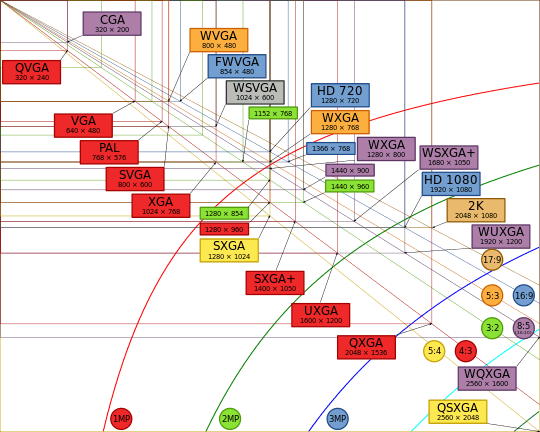IBM 8514
 | |
| Release date | 1987 |
|---|---|
| Cards | |
| Entry-level | IBM Image Adapter/A |
| History | |
| Predecessor | VGA |
| Successor | XGA |
IBM 8514 is an IBM graphics computer display standard supporting a display resolution of 1024x768 pixels with 256 colors at 43.5 Hz (interlaced), or 640x480 at 60 Hz (non-interlaced).[1] 8514 usually refers to the display controller hardware (such as the 8514/A display adapter.) However, IBM sold the companion CRT monitor (for use with the 8514/A) which carries the same designation, 8514.
8514 used a standardised programming interface called the "Adapter Interface" or AI. This interface is also used by XGA, IBM Image Adapter/A, and clones of the 8514/A and XGA such as the ATI Technologies Mach 32 and IIT AGX. The interface allows computer software to offload common 2D-drawing operations (line-draw, color-fill, BITBLT) onto the 8514 hardware. This freed the host CPU for other tasks, and greatly improved the speed of redrawing a graphics visual (such as a pie-chart or CAD-illustration).
History
8514 was introduced with the IBM Personal System/2 computers in April 1987. It was an optional upgrade to the Micro Channel architecture based PS/2's Video Graphics Array (VGA), and was delivered within three months of PS/2's introduction.
Although not the first PC video card to support hardware acceleration, IBM's 8514 is often credited as the first PC mass-market fixed-function accelerator. Up until the 8514's introduction, PC graphics acceleration was relegated to expensive workstation-class, graphics coprocessor boards. Coprocessor boards (such as the TARGA Truevision series) were designed around special CPU or digital signal processor (DSP) chips, which were programmable. Fixed-function accelerators, such as the 8514, sacrificed programmability for better cost/performance ratio.
Later compatible 8514 boards were based on the Texas Instruments TMS34010 chip.
8514 was later superseded by IBM XGA.
Software support
Software that supported this graphic standard:[2]
Clone hardware
Third-party graphics suppliers did not clone IBM's 8514 as extensively as VGA.
- ATI Technologies: the Mach8, Mach32,[1] Graphics Vantage and 8514/Ultra
- Chips&Technologies: F82C480 B EIZO - AA40 and F82C481 Miro Magic Plus
- Matrox: MG-108
- Paradise: Plus-A, Renaissance Rendition II
- Desktop Computing: AGA 1024
- NEC: Multisync Graphics Engine
- IIT AGX and Tseng ET4000 are also referenced as being IBM 8514 compatible.[2][3][4]
Output capabilities
8514 offered:
- 640×480 in 256 colors out of 262,144 (18 bit)
- 1024×768 in 256 colors out of 262,144 (18 bit)
- 640×480 text mode with 80x34 characters
- 1024×768 text mode with 85x38 characters
- 1024×768 text mode with 146x51 characters
Latter clone board offered additional resolutions:
- 800×600 with 16-bit and 24-bit color depths
- 1280×1024 with 16-bit and 24-bit color depths
See also
References
- ↑ 1.0 1.1 "The 8514/A Graphics Accelerator". OS/2 Museum. 2013-05-09. Retrieved 2014-06-19.
- ↑ 2.0 2.1 "IBM PS/2: 8514/A Graphics Standard". Theodor.lauppert.ws. Retrieved 2014-06-19.
- ↑ InfoWorld - Google Livros. 1990-07-16. Retrieved 2014-06-19.
- ↑ http://www.vgamuseum.info/index.php/component/content/article/59-vlasks-articles/index.php?option=com_customproperties&view=show&task=show&cp_made=&cp_bus=&cp_memsize=&cp_year=&cp_memory=&cp_family=&cp_cardtype=8514a&cp_owner=&cp_directx=&cp_opengl=&cp_pipelines=&cp_manufacturer=&cp_process=&cp_text_search=
Further reading
- Richter, Jake; Smith, Bud (April 1990). Graphics Programming for the 8514/A: The New PC Graphics Standard. M & T Books. ISBN 1-55851-086-9.
- Sanchez, Julio; Canton, Maria P. (February 26, 2003). The PC Graphics Handbook. CRC. ISBN 0-8493-1678-2.
This article is based on material taken from the Free On-line Dictionary of Computing prior to 1 November 2008 and incorporated under the "relicensing" terms of the GFDL, version 1.3 or later.
| ||||||||||||||||
